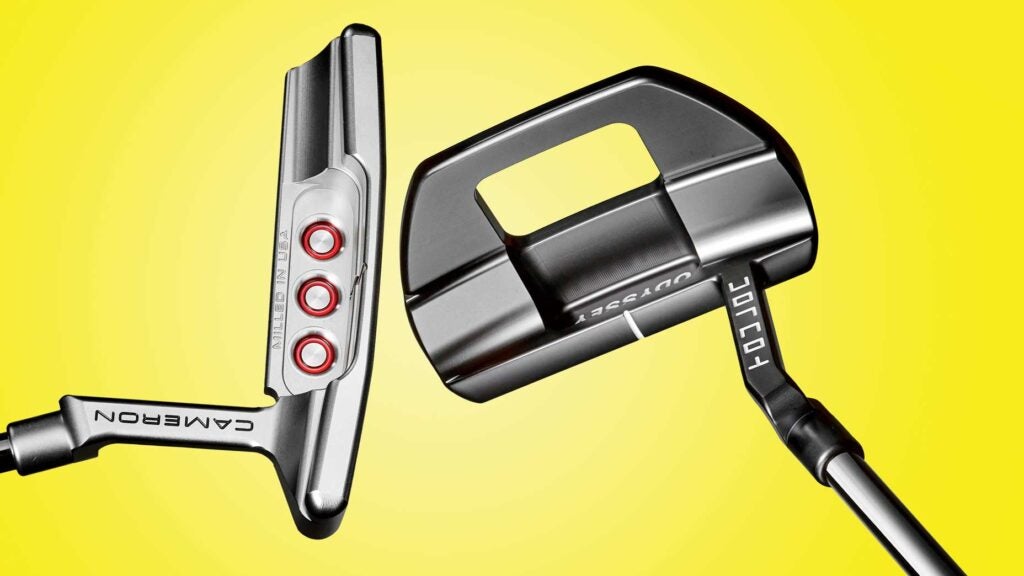For decades, the putter debate resembled Tiger Woods at the 2000 U.S. Open: It wasn’t even close to a fair fight. Wilson’s 8802, Titleist’s Bullseye and Ping’s Anser—one of the most important club designs in the history of the industry—dominated the putter landscape on pro circuits and in the recreational ranks. Golfers had to search hard for something that didn’t resemble one of the most popular head shapes—and even then, it wasn’t a guarantee you’d hit pay dirt.
It wasn’t until the late 1980s when Ram’s Zebra mallet wound up in the hands of three-time major winner Nick Price that golfers truly started to consider the idea of using something markedly different on the greens. Fast-forward four decades and mallets are no longer an afterthought in the marketplace. In fact, it could be debated that mallets are as popular, if not more popular, than their blade counterparts.
“It’s been a total flip in the last five years,” says Sean Toulon, Odyssey Golf ‘s general manager and the founder of Toulon Design. “Odyssey has always skewed more toward mallets, but we’ve seen them go from being a secondary option to the usage leader in the putter category.”
The “flip” Toulon is referencing can be traced back to two events. The first is the introduction of mallets with blade-like heel weighting (commonly referred to as “toe hang”) that opened the door for blade users who were interested in gaining more stability and forgiveness but still wanted some semblance of face rotation that wasn’t offered with a face-balanced model.
“Mallets have become more versatile with the addition of toe hang,” says Joe Toulon, Odyssey’s Tour rep, who noted roughly 60 to 65 percent of pros using an Odyssey putter opt for a mallet. “Mallets can work for any player depending on what they’re looking at, but the addition of toe hang has opened up new doors for pros who might not have considered a mallet in the past.”
Jason Day’s torrid 15-month stretch—the Aussie won eight times on Tour in 2015—also put mallet-style putters front and center. Specifically, TaylorMade’s unmistakable Spider Tour Red. When Day won the 2016 Players Championship with the red wand, the floodgates opened. Golfers of all skill levels suddenly wanted to put Day’s putter in their bag.
“The Tour drives what happens in the marketplace,” says Bill Price, TaylorMade’s senior director of product creation, putter and wedge. “We saw it with the rise in popularity of mallets just based off Jason’s incredible stretch with Spider.”
The numbers also paint a similar picture. In Odyssey’s case, current sales data reveals over 60 percent of putters purchased by retailers are of the mallet variety. An identical trend is also taking place on the PGA Tour, where anywhere from 60 to 70 percent of the Odyssey models in play on a given week are mallets.
A changing of the guard in the putter category has made many ponder the future of the blade. But don’t write it off just yet. Unlike persimmon and steel-faced drivers, traditional shapes aren’t going away anytime soon. Many blades have been reimagined in recent years with adjustable heel-toe weights that can deliver mallet-like stability, variable depth grooves for distance consistency and new head and face materials to dial in feel.
“I don’t think blades are dead,” Sean Toulon says. “I think we’re all looking at them through a different lens and trying to find new and inventive ways to improve upon the design, whether that’s construction or material.”
And for those who still long for classic blades and heel-toe designs without the bells and whistles, they still exist in the wild. So long as Tiger Woods continues to roll a milled Scotty Cameron Newport 2 GSS with a Ping PP58 grip, golfers will clamor for something closely resembling the putters employed by the best players in the world.
Looking at the list of putters used by the best in the PGA Tour’s Strokes Gained: Putting performance category, it’s obvious there’s no clear-cut winner. Blades and mallets of varying shapes can be found, which tells you one thing: Mallets may be winning in the usage category, but like most things in life, picking a putter is all about personal preference and what works best for your game.
Whether that’s a blade or mallet, you can rest easy knowing there are plenty of viable options at your disposal.
